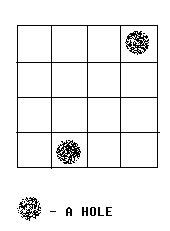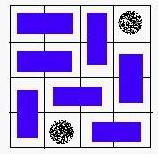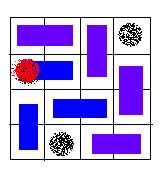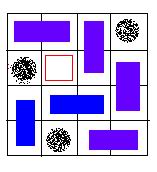poj 2446 Chessboard (二分图利用奇偶性匹配)
| Time Limit: 2000MS | Memory Limit: 65536K | |
| Total Submissions: 13176 | Accepted: 4118 |
Description
Alice and Bob often play games on chessboard. One day, Alice draws a board with size M * N. She wants Bob to use a lot of cards with size 1 * 2 to cover the board. However, she thinks it too easy to bob, so she makes some holes on the board (as shown in the
figure below).

We call a grid, which doesn’t contain a hole, a normal grid. Bob has to follow the rules below:
1. Any normal grid should be covered with exactly one card.
2. One card should cover exactly 2 normal adjacent grids.
Some examples are given in the figures below:

A VALID solution.

An invalid solution, because the hole of red color is covered with a card.

An invalid solution, because there exists a grid, which is not covered.
Your task is to help Bob to decide whether or not the chessboard can be covered according to the rules above.

We call a grid, which doesn’t contain a hole, a normal grid. Bob has to follow the rules below:
1. Any normal grid should be covered with exactly one card.
2. One card should cover exactly 2 normal adjacent grids.
Some examples are given in the figures below:

A VALID solution.

An invalid solution, because the hole of red color is covered with a card.

An invalid solution, because there exists a grid, which is not covered.
Your task is to help Bob to decide whether or not the chessboard can be covered according to the rules above.
Input
There are 3 integers in the first line: m, n, k (0 < m, n <= 32, 0 <= K < m * n), the number of rows, column and holes. In the next k lines, there is a pair of integers (x, y) in each line, which represents a hole in the y-th row, the x-th column.
Output
If the board can be covered, output "YES". Otherwise, output "NO".
Sample Input
4 3 2 2 1 3 3
Sample Output
YES
Hint

A possible solution for the sample input.
看能否恰好覆盖。
二分匹配:利用二分匹配。两个能匹配的格子的坐标和必定奇偶性不同。利用这一点能够降低时间耗费。
#include"stdio.h"
#include"string.h"
#include"queue"
using namespace std;
#define N 35
#define M 1200
int g[N][N],n,m;
int dir[4][2]={0,1,0,-1,-1,0,1,0};
int mark[M],link[M];
int judge(int x,int y)
{
if(x>=0&&x<n&&y>=0&&y<m)
return 1;
return 0;
}
int find(int k)
{
int i,j,x,y,di,dj;
x=k/m;
y=k%m;
for(i=0;i<4;i++)
{
di=dir[i][0]+x;
dj=dir[i][1]+y;
if(judge(di,dj)&&!g[di][dj])
{
j=di*m+dj;
if(!mark[j])
{
mark[j]=1;
if(link[j]==-1||find(link[j]))
{
link[j]=k;
return 1;
}
}
}
}
return 0;
}
int main()
{
int u,v,k,i,j;
while(scanf("%d%d%d",&n,&m,&k)!=-1)
{
memset(g,0,sizeof(g));
for(i=0;i<k;i++)
{
scanf("%d%d",&v,&u);
u--;v--;
g[u][v]=1;
}
if((n*m-k)&1)
{
printf("NO\n");
continue;
}
int ans=0;
memset(link,-1,sizeof(link));
for(i=0;i<n;i++)
{
for(j=0;j<m;j++)
{
if((i+j)%2==0||g[i][j]) //(i+j)奇偶性!!!
continue;
memset(mark,0,sizeof(mark));
ans+=find(i*m+j);
}
}
//printf("%d\n",ans);
if(ans*2==n*m-k)
printf("YES\n");
else
printf("NO\n");
}
return 0;
}


